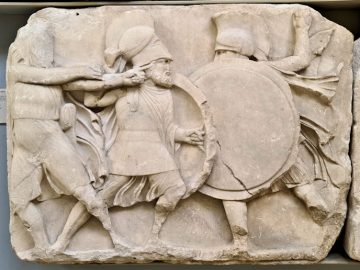When it comes to roman pottery, the area around Caerleon, in south Wales, seems to have been of quite some importance. And the National Roman Legionary Museum there has some very nice examples including of flagons, and it’s nice to think that roman soldiers drank wine from them in their downtime two thousand years ago. So I thought it would be nice to combine photogrammetry and digital sculpting to make my own roman flagon – not as an exact replica but more generally just as a representation of ancient drink flagons I could easily 3D print.
To that end I started by 3D scanning one in the Caerleon museum as a starting point, using 60 12mp smartphone photos and the excellent Kiri Engine photogrammetry Android app. That wasn’t really too difficult but I soon found there was a slight complication: as the flagon was in a glass display case it was surrounded by a lot of unwanted geometry. So I used the Kiri Engine crop tool and cut it down to just what is shown on the right side of the screengrab below.

Quick summary of this 3D creation
Overview: A 3D sculpted roman flagon based on photogrammetry.
Location: National Roman Legionary Museum, Caerleon, South Wales, United Kingdom [map].
Date/era: Roman, exact date unknown.
Software used: KiriEngine, NomadSculpt, Blender.
Intended use: 3D printing, either in resin or fused filament.
Download: Thingiverse and Thangs3D (non-commercial).
Following the scanning I transferred the high-poly cropped scan to Nomad Sculpt on an iPad. After reorienting the scan so the flagon was properly upright I further cropped the surroundings to remove unwanted bits of nearby items. Then I smoothed away the cracks as the original was reconstructed from parts, and fiddled with the shape a little, especially around the top of the handle. That helped ensure I could 3D print using fused-filament without needing supports. After that I made a reduced-size copy, without a handle, and with a new cylinder and cone I constructed a shape for the inside. With that subtracted from the main scan we end up with a hollow flagon. The screengrabs below show the flagon with and without the inside part, before it was prepared for 3D printing in Blender, including trimming the bottom to make a flat base.

I decided to try printing the flagon on my Flashforce Adventurer 3C fused-filament 3D printer, with a 0.4mm nozzle. I wanted to see how small I could make it so I decided to start at 100mm tall, followed by 50mm and 25mm. You can see the results of that below, printed using grey 1.75mm diameter PLA filament. I hope you’ll agree that they came out pretty good and, with a little sanding and priming, should be suitable for painting to look like genuine, albeit rather small, roman flagons.

So now we have a 3D-printable roman style drinks flagon that any self-respecting roman soldier would think perfect for his weekend wine tipple. Or, with some decimation and digital-painting we could also have our own digital-asset for historical Blender renders. Whichever, I hope you find it a fun historical 3D model 🙂




